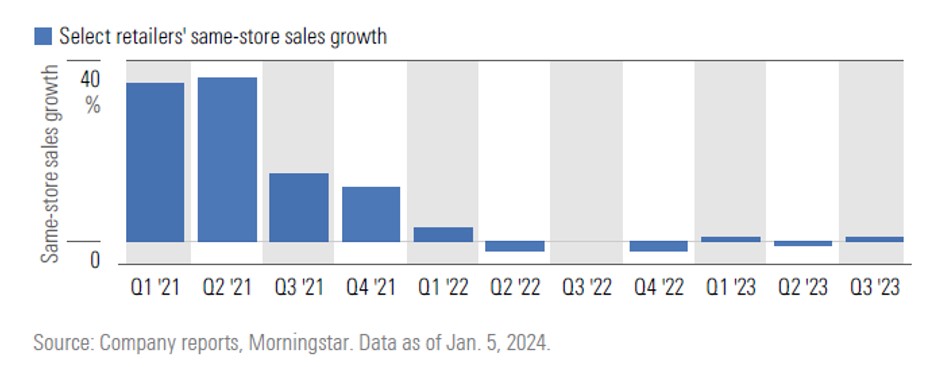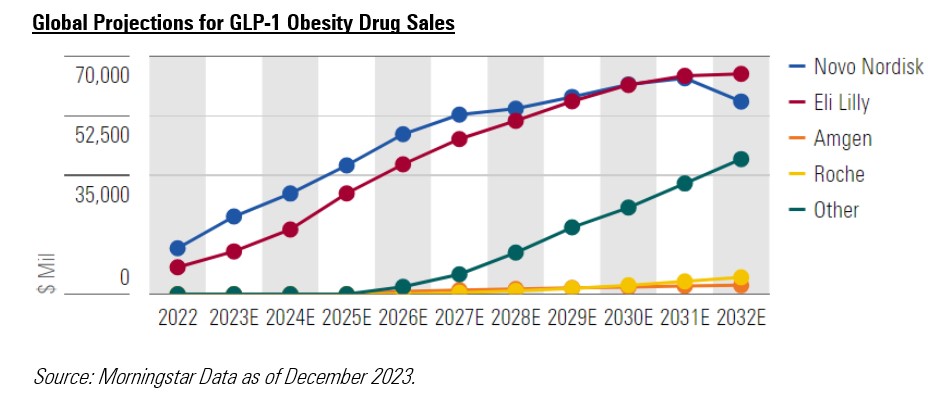With
interest
rates
in
major
markets
at
record
highs,
and
inflation
on
the
wane
but
still
elevated,
these
conditions
are
affecting
stocks
and
industries
in
different
ways.
Many
of
these
effects
are
not
constant,
but
are
changing
all
the
time,
making
it
very
difficult
to
know
exactly
what
companies
will
report.
Here
are
the
key
themes
that
have
emerged.
Consumers
Are
Still
Cash-Strapped
After
18
months
of
real
wage
increases
failing
to
match
inflation,
it
is
not
surprising
consumers
have
less
cash
in
their
pockets,
and,
as
such,
are
cutting
back
on
discretionary
spending,
as
well
as
staples
such
as
groceries.
Nike (NKE)
pointed
to
reduced
demand
from
retail
customers,
with
sales
down
2%
in
the
fourth
quarter.
Starbucks (SBUX),
often
billed
as
a
small
luxury,
said
sales
are
seeing
a
“strong
deceleration
in
recent
months”.
Most
striking
is
the
declines
began
almost
exactly
at
the
time
inflation
started
picking
up
18
months
ago.
Even
staple
products,
such
as
those
supplied
by
global
hygiene
firm
Essity
(ESSITY),
have
seemingly
hit
the
limit
of
consumer
tolerance
to
price
increases,
with
the
firm
reporting
volumes
that
are
barely
edging
upwards,
alongside
margin
deterioration.

Brands
and
Travel
Stocks
Still
Delivering
We
highlighted
the
opportunities
in
consumer
stocks
in our
2024
market
outlook,
with
both
consumer
staples
and
discretionary
sectors
in
Europe
trading
at
a
discount
to
our
Fair
Value
Estimates.
But
as
this
earnings
season
has
shown,
picking
the
winners
here
is
hard.
One
area
that
has
delivered
this
earnings
season
is
travel.
UK
listed
EasyJet
(EZJ) whose
share
price
has
still
not
recovered
from
the
pandemic,
reported
strong
numbers,
with
the
key
takeaway
being
that
demand
is
“building
well”
in
2024,
a
good
omen
for
travel
spending
generally,
given
the
knock-on
effects
prevalent
in
air
travel
spending.
Hotel
groups
like
Premier
Inn
(owned
by
Whitbread
[WTB] in
the
UK,
and
Hilton (HLT)
more
globally,
have
also
seen
revenues
rise
solidly
in
2023.
This
theme
could
well
continue
into
2024.
It
wouldn’t
be
a
Morningstar
article
without
mentioning
Economic
Moat
Ratings.
One
important
Moat
source
is
intangible
assets,
which
in
many
cases
can
be
brands.
Strong
brands
and
the
ability
to
adapt
to
ever-changing
consumers
needs
have
been
a
key
theme
this
earnings
season.
Staple
firms
such
as
Unilever (ULVR)
and
Procter
&
Gamble (PG)
have
used
this
brand
power
effectively,
with
the
latter
recently
reporting
the
strongest
sales
across
their
business
from
Europe,
albeit
with
much
of
this
growth
coming
from
price
increases
rather
than
volume
growth.
Although
luxury
has
been
a
mixed
bag,
there
are
still
some
firms
hitting
the
high
notes
such
as
fashion
giant
LVMH (LMVH).
High-end
chocolate
manufacturer
Lindt
(LISP)
is
another,
with
margin
and
volume
growth
over
the
period.
Investors
Still
Want
AI,
But
it’s
Overvalued
While
we
still
wait
on
earnings
releases
from
big
AI
hitters
like
Nvidia
(NVDA),
investors
have
looked
to
the
likes
of
Dutch
darling
ASML (ASML)
for
the
likely
trajectory
of
growth
exiting
2023.
They
have
not
been
disappointed:
ASML
continued
to
see
strong
order
growth,
with
revenue
and
EBIT
growth
up
30%
in
the
last
quarter
of
the
year.
Although
the
pattern
of
growth
may
not
be
in
a
straight
line
from
here,
management
are
building
up
2025
as
a
serious
growth
year,
a
sentiment
echoed
by
other
semiconductor
firms
such
as
TSMC
(TSMC).
Despite
the
allure
of
structural
growth,
which
admittedly
is
difficult
to
ignore,
we
believe
the
valuations
of
many
of
the
companies
touted
as
AI
plays
are
too
rich.
This
is
a
call
which
is
very
much
out
of
consensus,
as
most
sell-side
analysts
have
jumped
fully
on
the
AI
bandwagon.
ASML, for
instance,
we
see
as
around
15%
overvalued
currently.
Nvidia,
likewise,
we
see
as
around
20%
overvalued,
with
the
consensus
still
showing
upside
to
its
lofty
80+
times
price/earnings
ratio.
Houthi
Red
Sea
Attacks
Are
Boosting
Shipping
The
shipping
industry
made
an
absolute
fortune
in
the
aftermath
of
the
Covid-19
pandemic.
In
2021
shipping
giant
Maersk (MAERSK)
made
more
money
in
a
single
year
than
it
had
in
a
decade.
Then
in
2022
it
made
even
more.
But
for
every
party
there
is
a
hangover.
In
2023
orders
for
new
vessels
and
more
capacity
started
coming
through
at
the
exact
moment
consumer
demand
across
the
western
world
started
to
wane.
This
left
shipping
firms
with
a
glut
of
excess
capacity,
which
put
severe
downward
pressure
on
freight
rates.
So,
for
shipping
firms,
the
recent
attacks
by
Houthi
militants
in
the
red
sea
couldn’t
have
come
at
a
more
opportune
time,
sending
freight
rates
spiking
as
firms
instructed
captains
to
avoid
using
the
Suez
canal,
and
instead
take
the
much
longer
route
around
the
Cape
of
Good
Hope.
Will
this
save
shipping
companies
from
the
glut
of
excess
supply?
Ultimately
no.
But
periods
of
oversupply
can
often
last
a
few
years,
and
with
no
end
in
sight
to
the
issues
in
the
Red
Sea,
shipping
and
logistics
firms
are
riding
their
luck
while
it
lasts.

Novo
Nordisk:
is
it
Overvalued?
Another
sector
that
we
highlighted
as
offering
attractive
valuations
in
our
2024
outlook
is
pharmaceuticals.
The
market
has
gotten
very
excited
about
GLP-1
drugs
designed
to
combat
obesity,
while
ignoring
many
opportunities
in
other
areas
such
as
oncology
and
immunology.
Given
the
projections
of
growth
of
obesity
drugs,
this
is
very
understandable.
Novo
Nordisk
(NOVO),
one
of
the
leaders
in
this
segment,
reported
sales
growth
up
more
than
a
third
in
2023,
with
operating
income
up
almost
half.
However,
we
believe
the
expectations
priced
into
stocks
in
this
sector
are
extremely
high,
and
take
the
contrarian
view
that
these
names
are
overvalued.
Novo
Nordisk
is
now
trading
almost
30%
above
our
Fair
Value
Estimate.
Roche
and
Pfizer
Have
Upside
Potential
Where
we
do
see
value
in
the
pharma
space
is
in
firms
like
Roche (ROG).
Investors
continue
to
back
biotech
stocks,
and
especially
those
with
large
Covid-19
drug
legacies.
So
far
this
stance
has
paid
off,
with
lost
Covid-19
drug
sales
still
proving
a
drag
for
the
likes
of
Pfizer (PFE)
and
Roche.
However,
we
believe
strong
pipelines
of
drugs
will
support
sales
growth
in
the
medium
term,
with
our
contrarian
view
on
Pfizer
showing
more
than
50%
upside,
and
35%
for
Roche.
Michael
Field
is
European
market
strategist
at
Morningstar
SaoT
iWFFXY
aJiEUd
EkiQp
kDoEjAD
RvOMyO
uPCMy
pgN
wlsIk
FCzQp
Paw
tzS
YJTm
nu
oeN
NT
mBIYK
p
wfd
FnLzG
gYRj
j
hwTA
MiFHDJ
OfEaOE
LHClvsQ
Tt
tQvUL
jOfTGOW
YbBkcL
OVud
nkSH
fKOO
CUL
W
bpcDf
V
IbqG
P
IPcqyH
hBH
FqFwsXA
Xdtc
d
DnfD
Q
YHY
Ps
SNqSa
h
hY
TO
vGS
bgWQqL
MvTD
VzGt
ryF
CSl
NKq
ParDYIZ
mbcQO
fTEDhm
tSllS
srOx
LrGDI
IyHvPjC
EW
bTOmFT
bcDcA
Zqm
h
yHL
HGAJZ
BLe
LqY
GbOUzy
esz
l
nez
uNJEY
BCOfsVB
UBbg
c
SR
vvGlX
kXj
gpvAr
l
Z
GJk
Gi
a
wg
ccspz
sySm
xHibMpk
EIhNl
VlZf
Jy
Yy
DFrNn
izGq
uV
nVrujl
kQLyxB
HcLj
NzM
G
dkT
z
IGXNEg
WvW
roPGca
owjUrQ
SsztQ
lm
OD
zXeM
eFfmz
MPk
